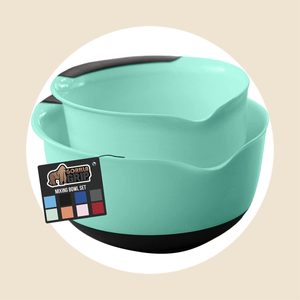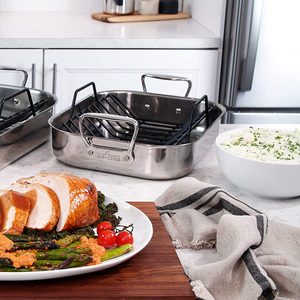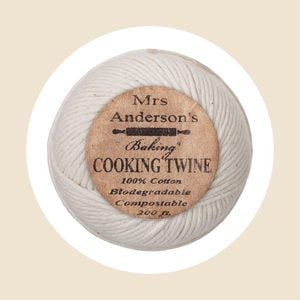I Made Ina Garten’s ‘Engagement Chicken,’ and People Love This Recipe for a Reason
Updated: Mar. 18, 2024
Can a roast chicken really lead to marriage? I tested Ina Garten's engagement chicken, and now I'm a believer!
Everyone loves a good roast chicken. If you make Ina Garten’s engagement chicken for someone you love, you may be rewarded with a proposal! It’s a beautiful roast flavored with onions, lemons and garlic, served with a simple pan gravy made from the drippings and white wine.
What’s the Story of Engagement Chicken?
Ina first learned about this chicken dish from the editors at Glamour magazine, who shared that whenever the staff made it for their significant others, they wound up with a marriage proposal. It sounds too good to be true, but there might be something to this fairy tale.
Megan Markle has been a longtime fan of Ina’s chicken recipes. She shared in an interview that Prince Harry proposed while making this dish on an intimate evening at their cottage. And they’re not the only couple to fall under the spell! Actress Emily Blunt shared on a podcast that when she and actor John Krasinski were dating, she wanted to make him “the roast chicken I love.” Of course, that’s Ina’s engagement chicken. Not long after, Krasinski proposed. “That’s it!” she said, “That’s all it took.”
If this sounds familiar, you may be thinking of other legendary dishes: Marry Me Chicken and Marry Me short ribs!
How to Make Ina Garten’s Engagement Chicken
Ina Garten says this chicken recipe serves three, but as is often the case with her recipes, we had plenty of leftovers. For cooking time, plan for about 20 minutes per pound of chicken.
Ingredients
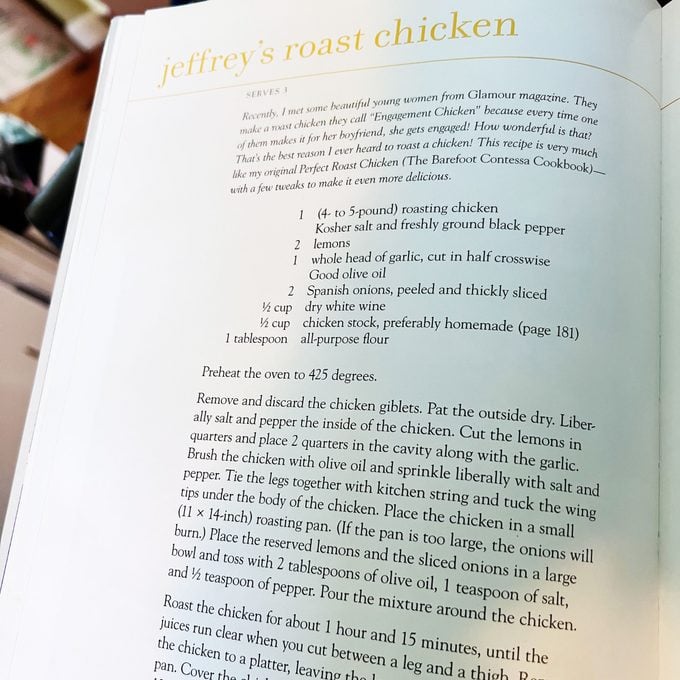
- 1 roasting chicken, 4-5 pounds
- Kosher salt
- Freshly ground black pepper
- 2 medium lemons
- 1 whole head of garlic, slice in half horizontally
- Good quality olive oil
- 2 Spanish or yellow onions, peeled and thickly sliced
- 1/2 cup dry white wine (such as pinot grigio or sauvignon blanc)
- 1/2 cup chicken stock, homemade if possible
- 1 tablespoon all-purpose flour
Tools
- Mixing Bowl: The lemons and onions are seasoned together in a bowl before roasting.
- Roasting Pan: Use a 14×11-inch pan or an ovenproof 3-quart saute pan—but no larger or the onions may burn.
- Kitchen Twine: This kitchen essential is used to tie the chicken legs.
Directions
Step 1: Prepare the chicken
Preheat the oven to 425°F. Remove and discard the giblets from the chicken, then use paper towel to pat it dry all over. Sprinkle a generous amount of salt and pepper inside the chicken cavity.
Step 2: Stuff and season the chicken
Slice both lemons into quarters. Place two of the quarters inside the chicken, along with both halves of the head of garlic. Brush the whole outside of the chicken with olive oil, then liberally sprinkle more salt and pepper over the surface. Use kitchen twine to tie the legs together and tuck the wings behind the body. Place the chicken in a 14×11-inch roasting pan.
Step 3: Prepare the onions and lemons
Place the remaining lemon quarters and the sliced onions in a large bowl. Add 2 tablespoons of olive oil, 1 teaspoon of salt and 1/2 teaspoon of black pepper; toss everything together until thoroughly coated. Pour the lemons and onions into the pan all around the chicken.
Step 4: Roast
Place the chicken in the oven and roast it for about 1 hour and 15 minutes. (Or roughly 20 minutes per pound.) The chicken is done when the juices run clear when you slice between the leg and thigh. (Or when the internal temperature is 165°.) Remove the pan from the oven; transfer the chicken to a platter and cover it with foil.
Step 5: Make the gravy
Place the roasting pan with the lemons and onions on a burner set to medium-high heat. Add in the white wine and use a wooden spoon to stir, scraping browned bits from the bottom. Add the chicken stock and the flour; stir constantly for about a minute until the gravy thickens. If any juices have gathered under the chicken, pour these into the gravy. Taste the gravy for seasoning, adding a little more salt or pepper if needed.
Step 6: Serve
Carve the chicken, then spoon the onions and gravy over the pieces. Serve immediately, hot or warm, with an extra sprinkle of salt. Encourage your guests to take the roasted lemons, too. They’ll be very tender and ready to eat, rind and all, with just a hint of bitterness that works well with the rich gravy.
And for dessert, make one of Ina’s chocolate cake.
Ina Garten’s Engagement Chicken FAQs
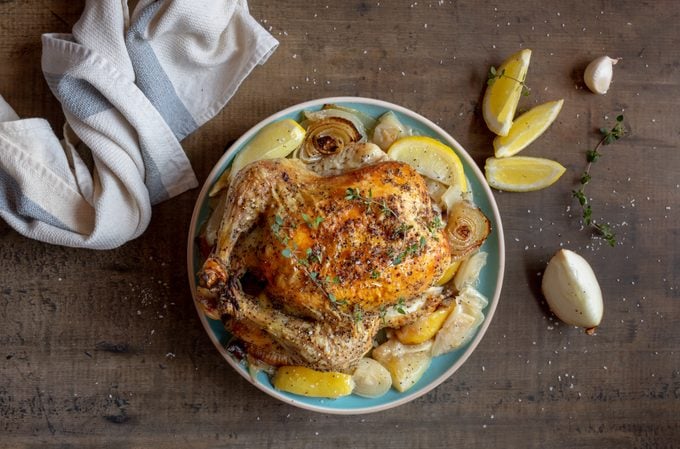
What cookbook is Ina’s engagement chicken in?
Everyone, including Ina, calls this dish “engagement chicken,” but when she first published the recipe it had a different name: Jeffrey’s Roast Chicken. It appears in her 2010 cookbook, Barefoot Contessa: How Easy Is That? and Jeffrey, of course, is her husband. He proposed to her long before she gained her culinary expertise, but dishes like this have undoubtedly contributed to their happy, 55-year marriage!
What temperature does Ina Garten roast a chicken?
Ina’s preferred oven temperature for her roast chicken recipes is 425°. This is high enough to give the bird a beautiful brown color and crispy skin while also cooking it through in roughly 20 minutes per pound. She prefers smaller-sized chickens in the range of three to six pounds, which means the overall cooking time is manageable for weeknight and weekend meals.
Does Ina Garten cover her roast chicken?
No, Ina leaves the chicken uncovered as it roasts. This allows the best color to develop on the surface and lets the skin get nice and crispy. Choosing a not-too-large roasting pan is important so that the lemons and onions are snug around the chicken and become tender without burning.
Try all of these favorite recipes from the Barefoot Contessa.
What does Ina Garten serve with her chicken?
With the tender lemons and onions, rich gravy and beautifully roasted chicken, the dish doesn’t really need much else to be a filling meal. Keep the focus on the Engagement Chicken by choosing simple sides like a fresh green salad or slices of country bread with butter to sop up the gravy. Ina’s favorite white wine to pair with lemon chicken is pinot grigio.





















